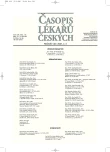Neurosteroids and Their Function
Authors:
M. Bičíková; Radek Hampl
Authors‘ workplace:
Endokrinologický ústav, Praha
Published in:
Čas. Lék. čes. 2007; 146: 223-226
Category:
Review Article
Overview
Neurosteroids are steroid structure hormones with neuroactive function. Neurosteroids have rapid, nongenomic actions in CNS. Non-conjugated metabolites of progesterone such as allopregnanolone, are potent positive modulators of GABAA receptors. They open ion channels for Cl⁻ with analgetic, hypnotic, anxiolytic and anticonvulsant effects. By sulphatation the modulation on GABAA receptors is changed to negative with opposite effect. 19-C–steroids as dehydroepiandrosterone and its sulphate are negative modulators of GABAA receptors acting as an excitant and proconvulsant. They are able to modulate positively N-methyl-D-aspartate (NMDA) receptors and open ion canals for Ca²⁺. Changed (lowered) neurosteroid levels can be involved in many pathological processes as premenstrual syndrome, stress, depression, some forms of epilepsy, Alzheimer disease etc. Future study targeted on regulation of their production and metabolism and understanding of the mechanism of their actions will help to use them therapeutically.
Key words:
enzymes, allopregnanolone, GABAA, NMDA, receptor.
Labels
Addictology Allergology and clinical immunology Angiology Audiology Clinical biochemistry Dermatology & STDs Paediatric gastroenterology Paediatric surgery Paediatric cardiology Paediatric neurology Paediatric ENT Paediatric psychiatry Paediatric rheumatology Diabetology Pharmacy Vascular surgery Pain management Dental HygienistArticle was published in
Journal of Czech Physicians

Most read in this issue
- Neurosteroids and Their Function
- Relationships Between the „Eating Inventory“ Factors, Socioeconomic Status, Anthropometric Body Adiposity Indexes and Health Risks in Czech Population
- Obesity Based on Mutation of Genes Involved in Energy Balance
- Growth Hormone Treatment in the Institute of Endocrinology
